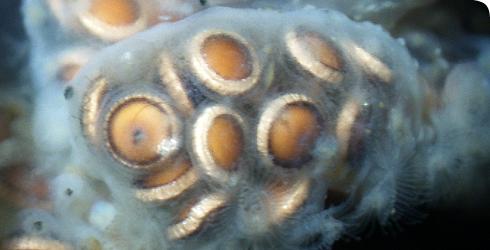Biology
Zooids are produced asexually by budding in linear series to either side of an interior, zooid-free strip.
A crown of tentacles called a lophophore extends from each zooid. These superficially contribute to the caterpillar-like appearance by resembling bristles.
Colonies are loosely attached via their muscular ‘foot’ to substrates such as wood, plants or rocks and can glide slowly over the surface.
Explosive growth and colony fission in early summer can result in high densities of colonies, with many hundreds of colonies deriving from initial founders (Okamura 1977; Wood & Okamura 2005).
Size
Colonies are approximately 0.5cm wide and about 2-5cm long, occasionally growing to 20cm long.
Lophophores of individual zooids are about 1mm diameter.
Life cycle
Colonies of Cristatella mucedo grow from early summer and degenerate in autumn.
The organism survives over winter by producing asexual seed-like statoblasts as the colony degenerates.
The statoblasts remain dormant and can be dispersed by water currents and aquatic birds. They hatch in late spring to found new colonies.
Sexual reproduction occurs briefly in early summer, but is not necessary for survival each year.
-

Reproduction and dispersal
Read about the asexual and sexual reproductive processes of Cristatella mucedo. Find out about the dispersal strategies of this species.
